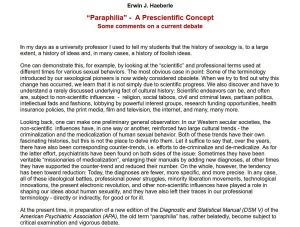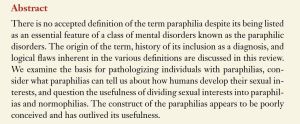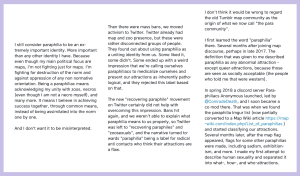One of our staff members is contributing considerably to a News Archiving service at Mu. Any well educated (Masters, PhD or above) users who wish to make comments on news sites, please contact Jim Burton directly rather than using this list, and we can work on maximising view count.
Paraphilia

Paraphilia is a poorly-defined term applied to nonstandard sexual interests, including pedophilia. It has been a category of mental disorder in the DSM since DSM-III; previous editions used the more openly prejudicial if synonymous label "sexual deviation."[1] The DSM-IV, for example, defined paraphilias as featuring "recurrent, intense sexually arousing fantasies, sexual urges, or behaviors generally involving 1) nonhuman objects, 2) the suffering or humiliation of oneself or one's partner, or 3) children or other nonconsenting persons that occur over a period of at least 6 months." John Money, who popularized the term, told Paidika in 1991 that "paraphilia" has no connotation of pathology,[2] yet the term has gone on to be used in classifying and marking prisoners for "treatment".[3]
Reception among MAPs
A minority of MAPs have embraced the term, some in an attempt to reclaim it (much in the style of Luciferans, Satanists and Queers). They sometimes point to the fact that since 2013, according to the DSM, to qualify as a psychiatric disorder, a "paraphilia" must be accompanied by negative factors such as distress.[4]
Paraphilia Identity (discussed later) is thought to help foster alliances with other self-identified paraphiles, sometimes on the basis they are "non-harmful" or not acted upon, indicating anti-contact beliefs. A minority of "pro-para" personas also describe themselves as "pro-recovery", implying reorientation, or otherwise recovery from the distress caused by the "disorder" of pedophilia.
Scholarly reception
Paraphilia has widespread support in the psychological sciences as a means of classifying people historically referred to as sexual deviants. Some have criticized this as a reification of outdated morality.
Dissent
Gisela Bleibtreu-Ehrenberg views paraphilias -- having "forbidden" or "atypical" thoughts -- as a resurrection of the 18th and 19th century concept of moral insanity.[5] Charles Moser has argued vigorously for the removal of all paraphilias from the DSM. The construct of paraphilia is a "pseudoscientific attempt to regulate sexuality," according to Moser.[6][7] Frederick Suppe has similarly argued that the DSM's classification of paraphilias is without empirical grounding and "merely the codification of social mores."[8]

Research
- Ahlers, C.J,Schaefer, G.A,Mundt, I.A,Roll, S,Englert, H,Willich, S.N,Beier, K.M. (2011) How Unusual Are the Contents of Paraphilias?: Paraphilia-Associated Sexual Arousal Patterns in Community-Based Sample of Men, Journal of Sexual Medicine, 8(5) 1362-1370
- "The percent of men that reported at least one PASAP [paraphilia-associated sexual arousal patterns] was 62.4%. In 1.7% of cases, PASAP were reported to have caused distress."
- "Pedophilic PASAP in sexual fantasies and in real-life sociosexual behavior was reported by 9.5% and 3.8% of participants, respectively."
- "The findings suggest that paraphilia-related experience can not be regarded as unusual from a normative perspective. At the same time, many men experience PASAP without accompanying problem awareness or distress, even when PASAP contents are associated with potentially causing harm to others."
Paraphile identity
There exists a large and growing paraphile community, as seen on Twitter, Tumblr and Fediverse. This was started around 2018 by Zoophiles (anti-contact and contact-complex) and MAPs (anti-c), but is intended to be more inclusive in terms of identity. Prior to this, pro-c Zoophile and Objectophile movements had existed (and still do), but had not identified primarily as Paraphiles.
Since there are over 500 (and ultimately limitless[9]) possibilities for identifying as a paraphile, or identifying new paraphilias, the community has significant unrealized growth potential, with much of its energy going into the process of defining new paraphilias and creating flags/symbols for them.
Some paraphilia discourse excludes MAPs, or includes them conditionally, on the basis of anti-contact beliefs, but the MAP-inclusive community has been growing in proportion to the MAP-exclusive paraphiliac community throughout the 20s. Pro-recovery beliefs are rare within online paraphilia communities, and the most common self-identified paraphilias are related to either Zoophilia and/or attraction to Minors, with considerable crossover between those two categories. It is not unusual for a person within this community to self-identify multiple paraphilias in the double or even triple digits.
It should be disclaimed that use of paraphilia labels is far from universal among MAPs as a whole, although some MAP activists have stated that it makes building long-lasting alliances with other groups easier, while reducing the chance of censorship and account suspensions; because paraphilias are assumed to be expressions of queerness. It may also be easier for a person to identify as a pedophile or other MAP if they list it among say, over 20 other self-identified paraphilias. Others criticize the embracing of paraphilic labels by MAPs (and the insistence that attraction to minors is but another "paraphilia") as similar to All Lives Matter's attempts to deprioritise the suffering of black people.
Neurodivergent paraphilia
Fediverse users have defined Neurodivergent paraphilia as any paraphilia they believe came about because of neurodivergence.[10]
Owning "extreme" labels
The community of self-identifying paraphiles has attempted to disarm some of the more harmful stereotypes surrounding popular demonology of sexual deviants by "owning" edgy labels such as "degenerate", "perv", "rapist", "cunny destroyer" and "kid-fucker". In some cases, these identities are adopted in order to role-play online fantasies, some of which might be related to deviance fetishism[11] instead of (or more than) attraction to minors.
There exists open debate within the Fediverse community as to how successful or otherwise these attempts may be, with some arguing that it only reinforces stereotypes. Younger members of the community appear to be more inclined towards adopting and defanging these extreme and implausible identities, while veterans remain wary of courting the kind of attention which saw activists, particularly self-identifying MAPs and Pedophiles prosecuted, imprisoned and legally restrained from the 1970s onward.
Official Guidance⁽ᵂʰᵃᵗ ᶦˢ ᵗʰᶦˢˀ⁾

Newgon Organization has for 15 years, opposed the idea that people with an attraction to minors are suffering from a "disorder". While we respect whatever identity others deem appropriate for themselves, most of us see the act of "reclaiming" the "paraphilia" label as glib, and inappropriate. "Paraphilias" are in fact historically ubiquitous, indistinct expressions of human diversity, and the language we use to describe them should attempt to reflect that.
To the above ends, and in the interests of our supporters and benefactors (who may themselves be MAPs):
Our co-operation with, and support for other identities considered "non-normative" must not be couched in language that suggests internalization of some medical "disorder" or "paraphilia". Yet at the same time, it can be accepted that most individuals within the public sphere remain ignorant of what paraphilias are meant to be, and previous attempts at reclaiming such identity labels have been part-successful.
MAPs are regardless, strong enough and numerous enough to establish a position as a main protagonist among the various battles of minority groups for recognition and acceptance. History tells us that this approach is very necessary indeed, in that it immunizes us against being sidelined.
This should not be taken to imply a lack of support for those who have adopted other identities, as in many cases, they have been invalidated in almost identical ways. But any alliance with Newgon, should it emerge organically, will be founded on that shared invalidation, not the archaic and offensive concept of MAPs as one necessary component of a larger "paraphilia" basket.
See also
External links
- Paraphilia - Wikipedia article written from the perspective of someone who supports "paraphilia" as a medical concept.
- List of paraphilias - Wikipedia listicle that claims up to 547 "paraphilic sexual interests" can be identified, and attempts to reify many. MAP Wiki, who endorse the "paraphilia" label are refining the list.
- (MAPs), Paraphiles and the Far Right - 2023 think piece by Newgon Strategist.
References
- ↑ DSM-II
- ↑ Geraci, Joseph and Mader, Donald (1991). "Interview: John Money," Paidika, 7, p. 4.
- ↑ The Development of a Scale for General Paraphilia - HM Prison and Probation Service, 2021, see also Pedophilia: Interventions That Work.
- ↑ MAP Wiki (Anti-contact Wiki) article on Paraphilia
- ↑ Blelbtreu-Ehrenberg, Gisela (1988). "The Paedophile Impulse: Toward the Development of an Etiology of Child-Adult Sexual Contacts from an Ethological and Ethnological Viewpoint," Paidika, 3, p. 36.
- ↑ Moser, C. (2001). "Paraphilia: A Critique of a Confused Concept," in P. J. Kleinplatz (ed.), New Directions in Sex Therapy: Innovations and Alternatives, pp. 91-108.
- ↑ Moser, C. & Kleinplatz, P.J. (2005). "DSM-IV-TR and the Paraphilias: An argument for removal," Journal of Psychology and Human Sexuality, 17(3/4), pp. 91-109.
- ↑ Suppe, F. (1984). "Classifying sexual disorders: The Diagnostic and Statistical Manual of the American Psychiatric Association," Journal of Homosexuality, 9(4), 9–28.
- ↑ Using the expanded list, researchers have determined that over half of the population might be able to identify as paraphilic. See, e.g. Mcmanus, Michelle & Hargreaves, Paul & Rainbow, Lee & Alison, Laurence. (2013), Paraphilias: Definition, diagnosis and treatment., Joyal CC, Carpentier J. The Prevalence of Paraphilic Interests and Behaviors in the General Population: A Provincial Survey. J Sex Res. 2017 Feb;54(2):161-171. doi: 10.1080/00224499.2016.1139034. Epub 2016 Mar 3. PMID: 26941021, Castellini G, Rellini AH, Appignanesi C, Pinucci I, Fattorini M, Grano E, Fisher AD, Cassioli E, Lelli L, Maggi M, Ricca V. Deviance or Normalcy? The Relationship Among Paraphilic Thoughts and Behaviors, Hypersexuality, and Psychopathology in a Sample of University Students. J Sex Med. 2018 Sep;15(9):1322-1335. doi: 10.1016/j.jsxm.2018.07.015. PMID: 30224020.
- ↑ Flags created to represent Neurodivergent paraphilias
- ↑ UD: Gooning